Walthamstow Council Tramways
Summary
Several photos have survived which indicate that formal uniforms, with the exception of caps, were not available in time for the earliest services. Uniforms were however soon issued, and these took the form of double-breasted 'lancer-style' tunics with five pairs of brass buttons, narrowing from top to bottom; the buttons bore a monogram of 'WDC' initials (see link). The tunics were made of blue serge, piped in red, and had upright collars; the latter bore an employee number on the bearer's left-hand side, preceded by either a 'C' for conductor or 'M' for motorman, and 'W C T' initials on the right-hand side. Caps were military in style with a wide, tensioned crown (top), and carried standard, 'off-the-shelf', script-lettering grade badges — Motorman or Conductor — which were presumably brass to match the buttons and the collar insignia. Uniforms remained in this style to the late Edwardian era, when a change was made to single-breasted jackets with five buttons, two breast pockets (with button closures), upright collars and epaulettes; the collars continued to bear the same badges as previously. This style of uniform appears however not to have survived for long, a relatively quick return being made to 'lancer-style' tunics. In the 1920s, although still favouring the 'lancer' style, the upright collars were dispensed with in favour of high, fold-over collars.
Following Walthamstow's elevation to borough status in 1929, the system was rebranded as 'Walthamstow Corporation Tramways', and staff were issued with a new cap badge comprising the borough arms above a quote from William Morris: 'Fellowship is Life'. This badge appears to have initially been worn above the script-lettering grade badge, but ultimately superseded the latter completely. A more modern style of double-breasted jacket was introduced around 1930, though many photographs indicate that the old 'lancer-style' tunics persisted for some time.
Motormen and conductors were also issued with long double-breasted overcoats with five pairs of buttons and high, fold-over collars. In common with all London tramway systems, tramcar staff were required to wear enamel Public Carriage Office licences issued by the Metropolitan Police Commissioner (see link).
Inspectors were issued with single-breasted jackets with hidden buttons (or a hook and eye affair), edged in a finer material than the main jacket, and with upright collars; the latter carried the designation Inspector in embroidered script lettering. Caps were in a squat, soft-topped style and like the collars, carried Inspector in embroidered script lettering. The uniform may have changed in later years, however, photographic evidence is currently lacking.
Female staff, who were employed in significant numbers during the Great War to replace men lost to the armed services, were issued with long skirts and long single-breasted jackets with five buttons, high fold-over collars and epaulettes; the latter fastened with a button at the neck end. As with male staff, the jackets bore individual ‘W C T’ letters on the bearer's right-hand collar and an employee number and designation on the left. Headgear took the form of a large baggy cap, which bore a brass script-lettering grade badge Conductor. Following persistent petitioning of the Metropolitan Police Commissioner, the latter reluctantly agreed on 25th May 1918 that Walthamstow's ladies could be trained as motorwomen; however, licences were never issued, so they never actually drove the trams in service. A photograph of the training has fortunately survived (see below), which shows that ladies undergoing instruction were issued with long, single-breasted, light-coloured waterproof coats which had high fold-over collars of a darker colour; these garments do not appear to have carried any insignia.
For a history of the system, see: 'The Tramways of East London' by Rodinglea; The Tramway & Light Railway Society and The Light Railway Transport League (1967).
Images
Motormen and conductors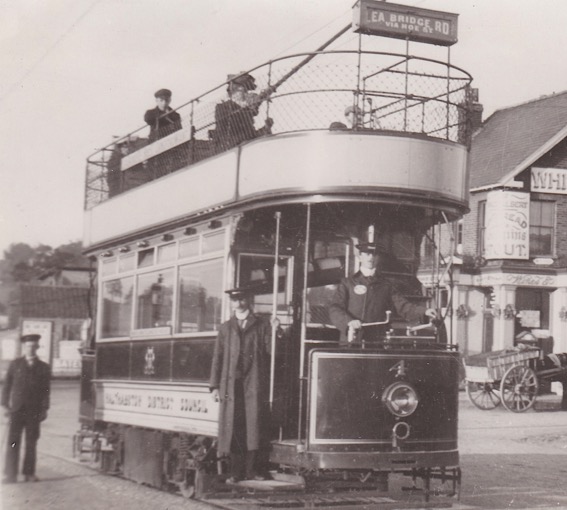
Tramcar No 4 at Chingford Mount terminus in 1905. The individual at the rear, holding a points iron, is almost certainly a Points Boy; although he is wearing a uniform cap, he does not appear to be wearing a uniform. The motorman (at the controls) clearly has an official cap and long coat, but the situation with respect to the uniform is less clear, as his shirt collars are on view, and the standard 'lancer-style' tunic would have hidden these. The most likely explanation for this is that the photo was taken in the first weeks of the system's life, and that uniforms had yet to arrive. Photo courtesy of the Tramways and Light Railway Society, with thanks to Eddie Dawes.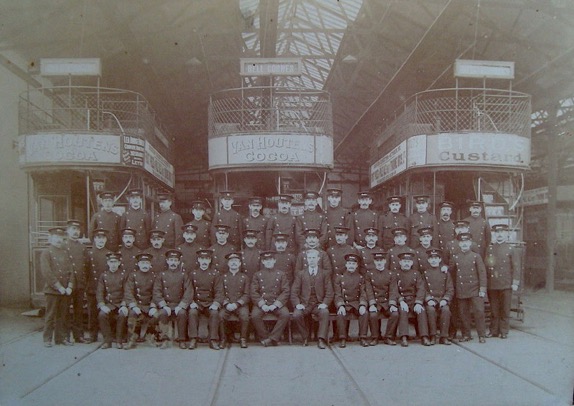
A line up of motormen and conductors at Walthamstow's depot on Chingford Rd — photo undated, but probably taken in 1906 given that the tramcars are carrying advertisements. It is possible that the photo was taken to mark the issuance of uniforms. With thanks to Stephen Howarth.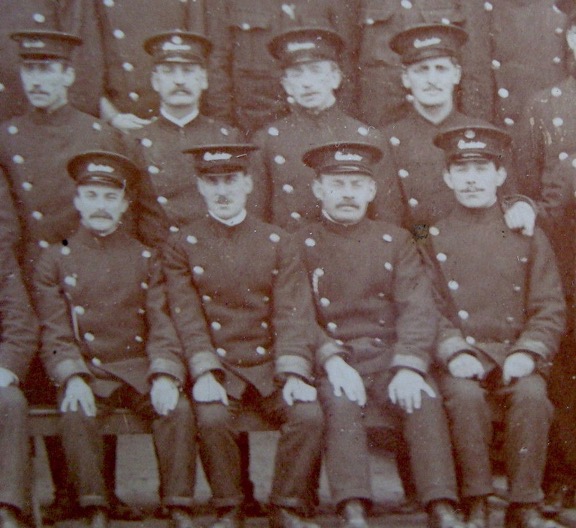
A blow-up of the above photo showing eight motormen and conductors in what are probably brand-new, double-breasted, 'lancer-style' tunics, though lacking collar insignia. Although the subjects are all wearing standard script-lettering grade badges, two of them also have a small round cap badge of unknown pattern.
Standard, ‘off the shelf’ script-lettering cap badges of the type used by Walthamstow Council Tramways — brass. Author's Collection.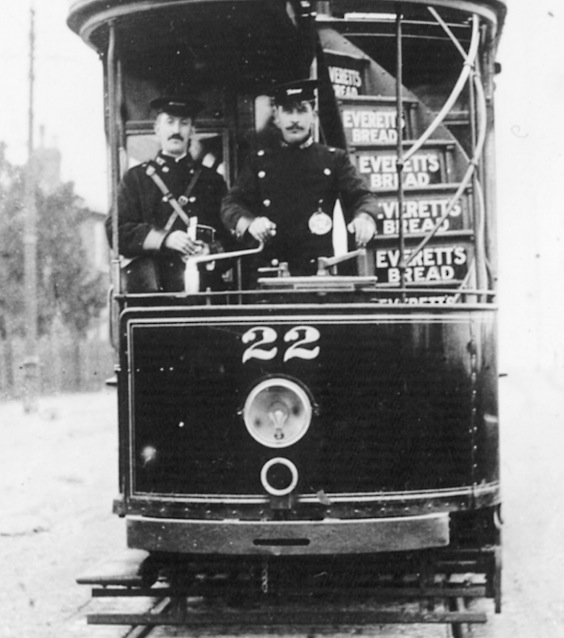
Conductor and motorman at the controls of Tramcar No 22 at Chingford Mount — photo undated, but probably taken in 1906 or 1907. The tunic collars bear system initials and an employee number. Photo courtesy of the Tramways and Light Railway Society, with thanks to David Voice.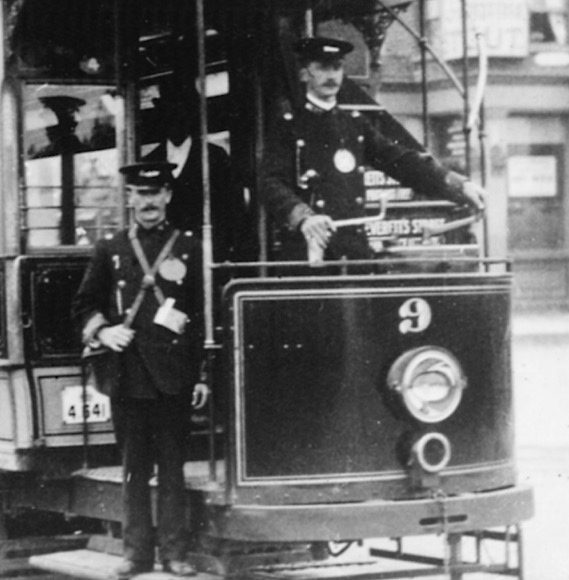
The crew of Tramcar No 9 pose for the camera at what seems to have been a favourite haunt of local photographers, the terminus at Chingford Mount - photo undated, but probably taken in 1906 judging by the excellent condition of the tram. Photo courtesy of the Tramways and Light Railway Society, with thanks to David Voice.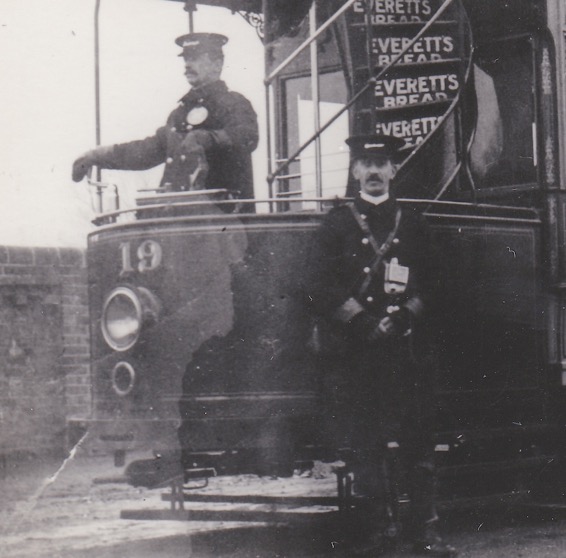
The crew of Tramcar No 19 in double-breasted greatcoats in Ferry Lane — photo taken in 1906. Photo courtesy of the Tramways and Light Railway Society, with thanks to Eddie Dawes.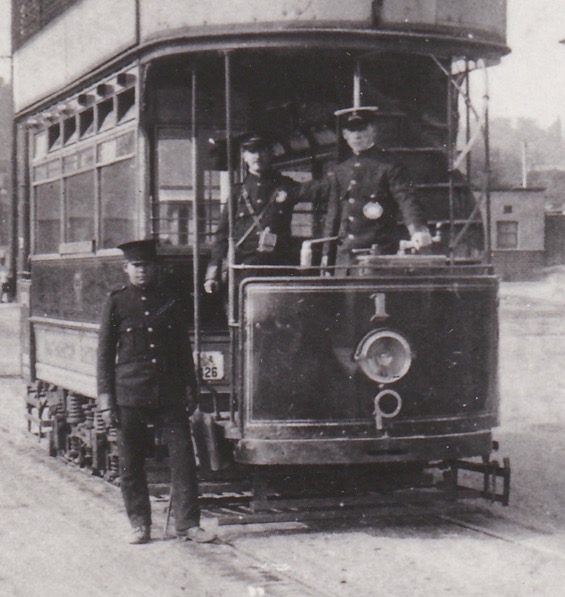
The crew of Tramcar No 1 pose for the cameraman at Chingford Mount, along with a Points Boy (holding a points iron) — photo purportedly taken around 1910. All present are wearing single-breasted jackets with plain collars. Photo courtesy of the Tramways and Light Railway Society, with thanks to Eddie Dawes.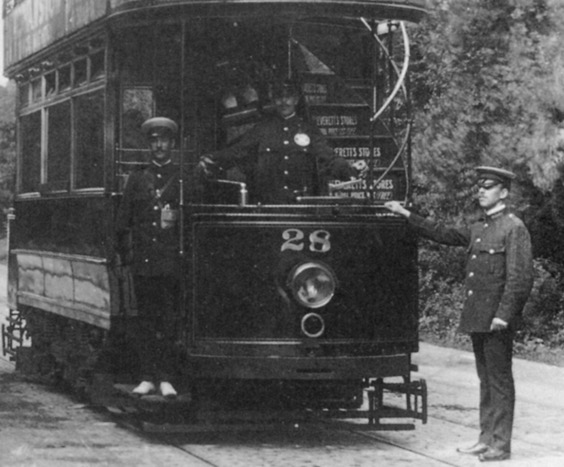
A conductor — in rather fetching white shoes — motorman, and an unknown grade, possibly a timekeeper, with Tramcar No 28 in Woodford New Road - photo purportedly taken around 1910. All present are wearing single-breasted jackets with epaulettes. Photo courtesy of the Tramways and Light Railway Society, with thanks to David Voice.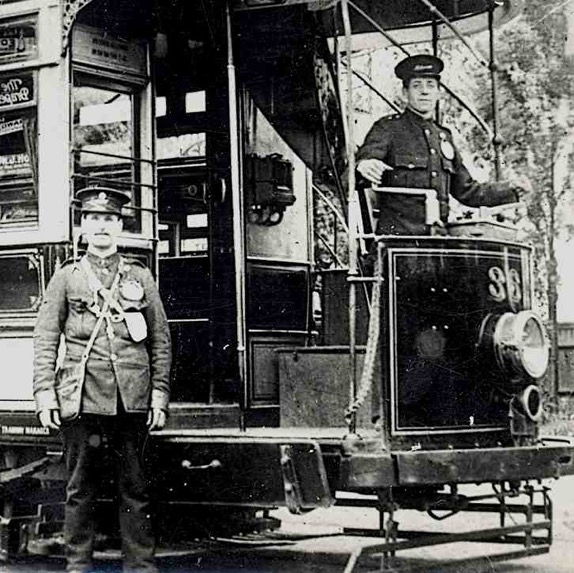
Conductor and motorman captured for posterity in the depot yard with newly delivered Tramcar No 36 in 1910. Both men are in single-breasted jackets, with the conductor also wearing the small round cap badge which is occasionally seen in other photos. With thanks to the Vestry House Museum (see link).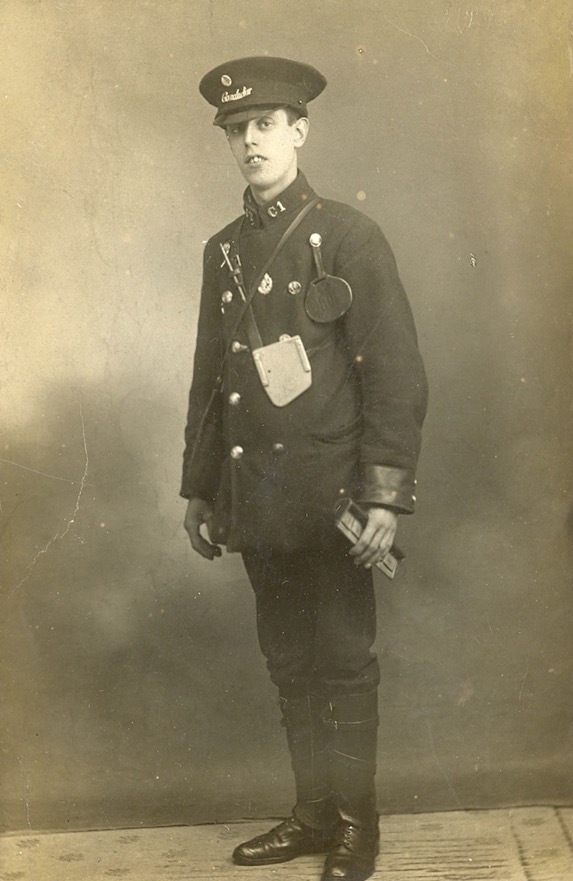
Conductor ‘C1’, William Henry Tucker - photo undated, but probably taken around the time of the Great War. Mr Tucker later became a Motorman, driving the route along Blackhorse Rd in Walthamstow in the early 1930s. With thanks to the Vestry House Museum (see link).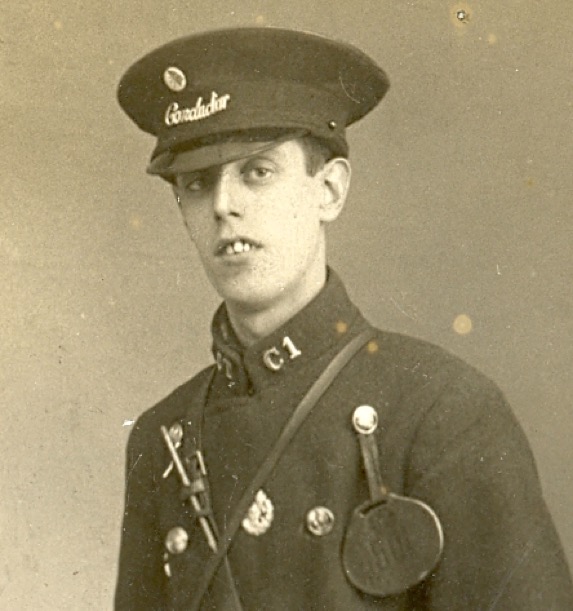
A blow-up of the above photo showing details of the uniform, including PCO ‘Conductor’ licence (see link), possibly No 1501. The round badge worn above the script lettering ‘Conductor’ badge, as well as the wreath pattern badge worn in the middle of his tunic are of unknown pattern, though the latter is likely to have been a regimental badge (this was a very common practice amongst tramway staff who had served during the Great War). 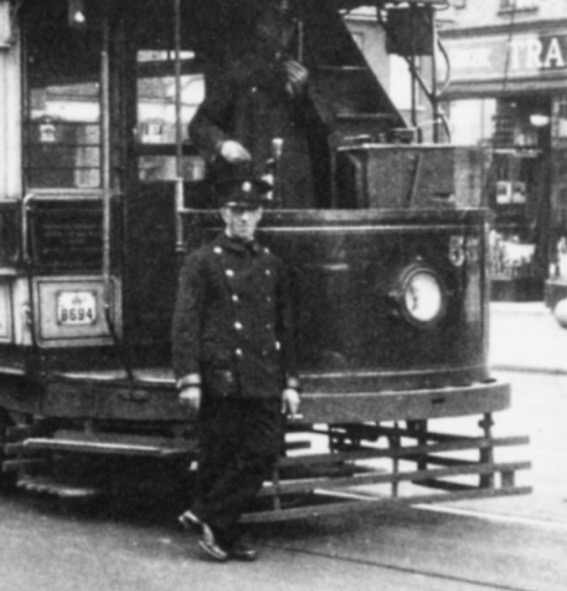
A conductor, cigarette in hand, poses for the camera with bogie Tramcar No 55 on a '57' through service to Liverpool St — photo undated, but certainly taken between 1929, when Walthamstow became a borough, and 1933 when the system passed to the new London Passenger Transport Board. Note the new cap badge, which was issued in 1929, gradually replacing the old script-lettering grade badges, though several photos appear to show them being worn together. Photo courtesy of the Tramways and Light Railway Society, with thanks to David Voice.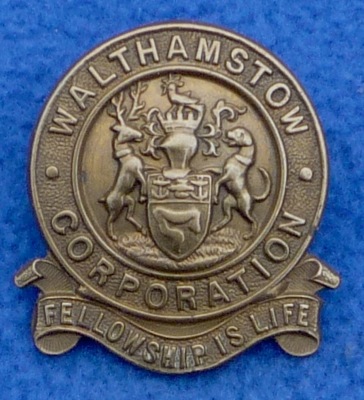
Cap badge issued to tramcar staff from 1929 onwards to mark Walthamstow's elevation to borough status; the motto is a quote from William Morris — brass. Author's Collection.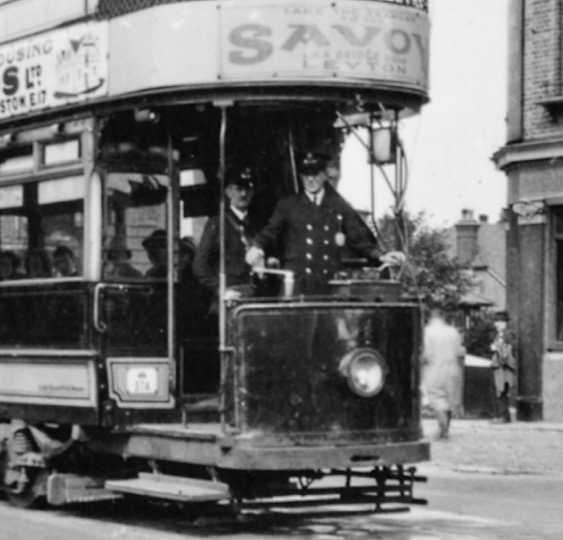
The crew of Tramcar 34 on Service 3 (Ferry Lane to Woodford) — photo undated, but definitely taken after 1927 when this route number was introduced, but before the creation of the LPTB in 1933. The motorman is wearing a more modern double-breasted jacket with lapels. Photo courtesy of the Tramways and Light Railway Society, with thanks to David Voice.
Senior staff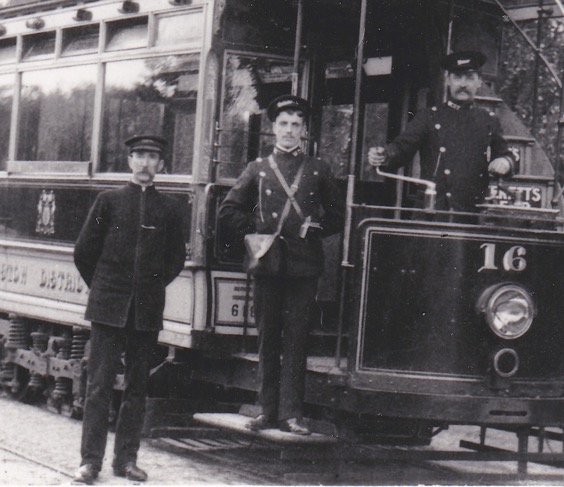
An inspector and somewhat casual looking conductor with Ferry Lane-bound Tramcar No 16 - photo undated, but given the pristine condition of the tram, probably taken in 1906. The motorman appears to be wearing a Driver cap badge rather than the usual Motorman pattern. Photo courtesy of the Tramways and Light Railway Society, with thanks to Eddie Dawes.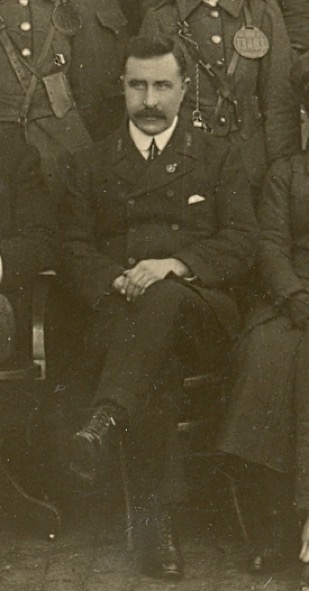
A blow up of a Great War staff photo (see below) showing a uniformed member of the senior staff, who could well be an inspector or chief inspector, though this is far from certain.
Female staff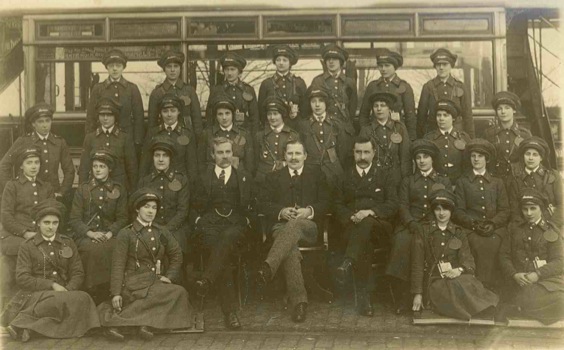
Walthamstow was the first London system to employ female staff (in December 1915), all of whom were conductresses; this photograph was very probably taken to reflect this pioneering step. With thanks to the Vestry House Museum (see link).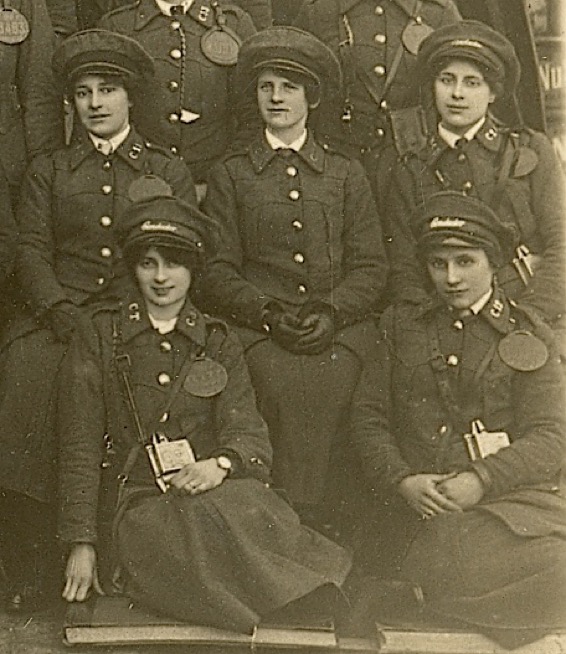
A blow up of the above photo showing five of the conductresses, two of whom are without their cap badges. The collar designations — 'W C T' and 'C x' — are easily made out, and would almost certainly have been in individual brass numerals/letters. With thanks to the Vestry House Museum (see link).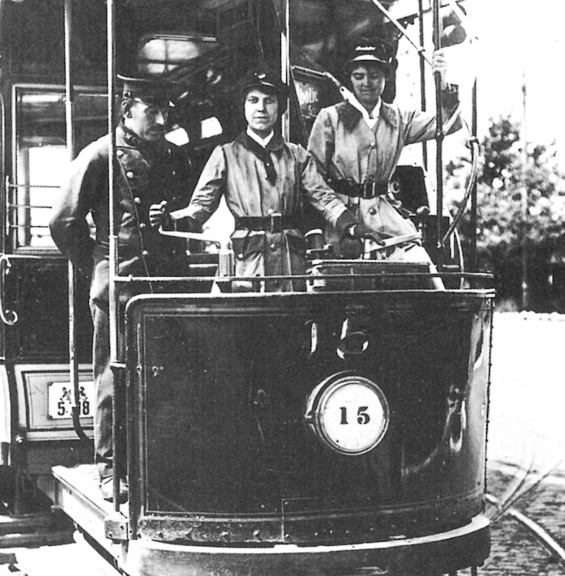
Two trainee motorwomen at the controls of Tramcar No 15 — photo undated, but very probably taken in summer 1918. Although the Metropolitan Police agreed to training on 25th May 1918, they eventually refused to issue licences, so none of the ladies ever drove the trams in an official capacity. Photo courtesy of the Tramways and Light Railway Society, with thanks to David Voice.